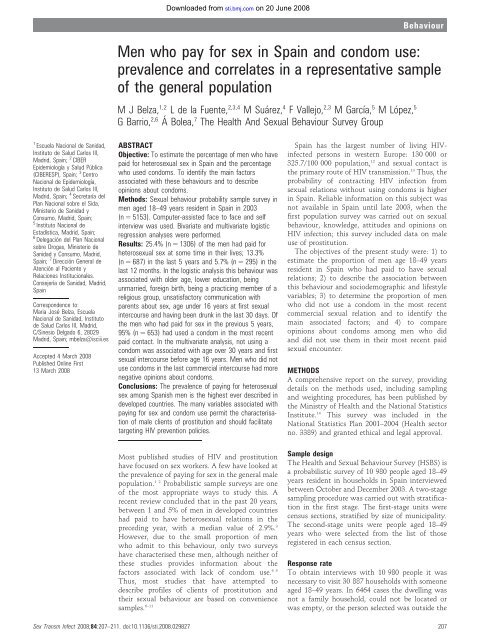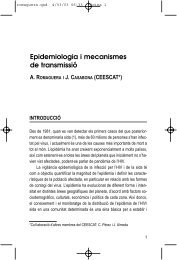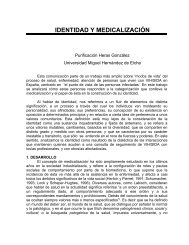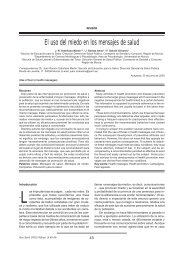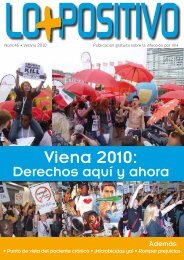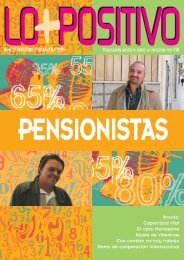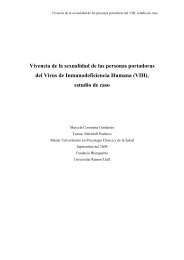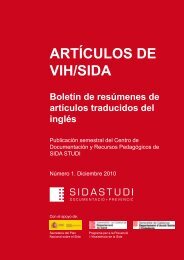Men who pay for sex in Spain and condom use ... - Sida Studi
Men who pay for sex in Spain and condom use ... - Sida Studi
Men who pay for sex in Spain and condom use ... - Sida Studi
You also want an ePaper? Increase the reach of your titles
YUMPU automatically turns print PDFs into web optimized ePapers that Google loves.
Downloaded from sti.bmj.com on 20 June 2008<br />
<strong>Men</strong> <strong>who</strong> <strong>pay</strong> <strong>for</strong> <strong>sex</strong> <strong>in</strong> Spa<strong>in</strong> <strong>and</strong> <strong>condom</strong> <strong>use</strong>:<br />
prevalence <strong>and</strong> correlates <strong>in</strong> a representative sample<br />
of the general population<br />
M J Belza, 1,2 L de la Fuente, 2,3,4 M Suárez, 4 F Vallejo, 2,3 M García, 5 MLópez, 5<br />
G Barrio, 2,6 Á Bolea, 7 The Health And Sexual Behaviour Survey Group<br />
Behaviour<br />
1 Escuela Nacional de Sanidad,<br />
Instituto de Salud Carlos III,<br />
Madrid, Spa<strong>in</strong>; 2 CIBER<br />
Epidemiología y Salud Pública<br />
(CIBERESP), Spa<strong>in</strong>; 3 Centro<br />
Nacional de Epidemiología,<br />
Instituto de Salud Carlos III,<br />
Madrid, Spa<strong>in</strong>; 4 Secretaría del<br />
Plan Nacional sobre el <strong>Sida</strong>,<br />
M<strong>in</strong>isterio de Sanidad y<br />
Consumo, Madrid, Spa<strong>in</strong>;<br />
5 Instituto Nacional de<br />
Estadística, Madrid, Spa<strong>in</strong>;<br />
6 Delegación del Plan Nacional<br />
sobre Drogas, M<strong>in</strong>isterio de<br />
Sanidad y Consumo, Madrid,<br />
Spa<strong>in</strong>; 7 Dirección General de<br />
Atención al Paciente y<br />
Relaciones Institucionales.<br />
Consejería de Sanidad, Madrid,<br />
Spa<strong>in</strong><br />
Correspondence to:<br />
Maria José Belza, Escuela<br />
Nacional de Sanidad, Instituto<br />
de Salud Carlos III, Madrid,<br />
C/S<strong>in</strong>esio Delgado 6, 28029<br />
Madrid, Spa<strong>in</strong>; mbelza@isciii.es<br />
Accepted 4 March 2008<br />
Published Onl<strong>in</strong>e First<br />
13 March 2008<br />
ABSTRACT<br />
Objective: To estimate the percentage of men <strong>who</strong> have<br />
paid <strong>for</strong> hetero<strong>sex</strong>ual <strong>sex</strong> <strong>in</strong> Spa<strong>in</strong> <strong>and</strong> the percentage<br />
<strong>who</strong> <strong>use</strong>d <strong>condom</strong>s. To identify the ma<strong>in</strong> factors<br />
associated with these behaviours <strong>and</strong> to describe<br />
op<strong>in</strong>ions about <strong>condom</strong>s.<br />
Methods: Sexual behaviour probability sample survey <strong>in</strong><br />
men aged 18–49 years resident <strong>in</strong> Spa<strong>in</strong> <strong>in</strong> 2003<br />
(n = 5153). Computer-assisted face to face <strong>and</strong> self<br />
<strong>in</strong>terview was <strong>use</strong>d. Bivariate <strong>and</strong> multivariate logistic<br />
regression analyses were per<strong>for</strong>med.<br />
Results: 25.4% (n = 1306) of the men had paid <strong>for</strong><br />
hetero<strong>sex</strong>ual <strong>sex</strong> at some time <strong>in</strong> their lives; 13.3%<br />
(n = 687) <strong>in</strong> the last 5 years <strong>and</strong> 5.7% (n = 295) <strong>in</strong> the<br />
last 12 months. In the logistic analysis this behaviour was<br />
associated with older age, lower education, be<strong>in</strong>g<br />
unmarried, <strong>for</strong>eign birth, be<strong>in</strong>g a practic<strong>in</strong>g member of a<br />
religious group, unsatisfactory communication with<br />
parents about <strong>sex</strong>, age under 16 years at first <strong>sex</strong>ual<br />
<strong>in</strong>tercourse <strong>and</strong> hav<strong>in</strong>g been drunk <strong>in</strong> the last 30 days. Of<br />
the men <strong>who</strong> had paid <strong>for</strong> <strong>sex</strong> <strong>in</strong> the previous 5 years,<br />
95% (n = 653) had <strong>use</strong>d a <strong>condom</strong> <strong>in</strong> the most recent<br />
paid contact. In the multivariate analysis, not us<strong>in</strong>g a<br />
<strong>condom</strong> was associated with age over 30 years <strong>and</strong> first<br />
<strong>sex</strong>ual <strong>in</strong>tercourse be<strong>for</strong>e age 16 years. <strong>Men</strong> <strong>who</strong> did not<br />
<strong>use</strong> <strong>condom</strong>s <strong>in</strong> the last commercial <strong>in</strong>tercourse had more<br />
negative op<strong>in</strong>ions about <strong>condom</strong>s.<br />
Conclusions: The prevalence of <strong>pay</strong><strong>in</strong>g <strong>for</strong> hetero<strong>sex</strong>ual<br />
<strong>sex</strong> among Spanish men is the highest ever described <strong>in</strong><br />
developed countries. The many variables associated with<br />
<strong>pay</strong><strong>in</strong>g <strong>for</strong> <strong>sex</strong> <strong>and</strong> <strong>condom</strong> <strong>use</strong> permit the characterisation<br />
of male clients of prostitution <strong>and</strong> should facilitate<br />
target<strong>in</strong>g HIV prevention policies.<br />
Spa<strong>in</strong> has the largest number of liv<strong>in</strong>g HIV<strong>in</strong>fected<br />
persons <strong>in</strong> western Europe: 130 000 or<br />
325.7/100 000 population, 12 <strong>and</strong> <strong>sex</strong>ual contact is<br />
the primary route of HIV transmission. 13 Thus, the<br />
probability of contract<strong>in</strong>g HIV <strong>in</strong>fection from<br />
<strong>sex</strong>ual relations without us<strong>in</strong>g <strong>condom</strong>s is higher<br />
<strong>in</strong> Spa<strong>in</strong>. Reliable <strong>in</strong><strong>for</strong>mation on this subject was<br />
not available <strong>in</strong> Spa<strong>in</strong> until late 2003, when the<br />
first population survey was carried out on <strong>sex</strong>ual<br />
behaviour, knowledge, attitudes <strong>and</strong> op<strong>in</strong>ions on<br />
HIV <strong>in</strong>fection; this survey <strong>in</strong>cluded data on male<br />
<strong>use</strong> of prostitution.<br />
The objectives of the present study were: 1) to<br />
estimate the proportion of men age 18–49 years<br />
resident <strong>in</strong> Spa<strong>in</strong> <strong>who</strong> had paid to have <strong>sex</strong>ual<br />
relations; 2) to describe the association between<br />
this behaviour <strong>and</strong> sociodemographic <strong>and</strong> lifestyle<br />
variables; 3) to determ<strong>in</strong>e the proportion of men<br />
<strong>who</strong> did not <strong>use</strong> a <strong>condom</strong> <strong>in</strong> the most recent<br />
commercial <strong>sex</strong>ual relation <strong>and</strong> to identify the<br />
ma<strong>in</strong> associated factors; <strong>and</strong> 4) to compare<br />
op<strong>in</strong>ions about <strong>condom</strong>s among men <strong>who</strong> did<br />
<strong>and</strong> did not <strong>use</strong> them <strong>in</strong> their most recent paid<br />
<strong>sex</strong>ual encounter.<br />
METHODS<br />
A comprehensive report on the survey, provid<strong>in</strong>g<br />
details on the methods <strong>use</strong>d, <strong>in</strong>clud<strong>in</strong>g sampl<strong>in</strong>g<br />
<strong>and</strong> weight<strong>in</strong>g procedures, has been published by<br />
the M<strong>in</strong>istry of Health <strong>and</strong> the National Statistics<br />
Institute. 14 This survey was <strong>in</strong>cluded <strong>in</strong> the<br />
National Statistics Plan 2001–2004 (Health sector<br />
no. 3389) <strong>and</strong> granted ethical <strong>and</strong> legal approval.<br />
Most published studies of HIV <strong>and</strong> prostitution<br />
have foc<strong>use</strong>d on <strong>sex</strong> workers. A few have looked at<br />
the prevalence of <strong>pay</strong><strong>in</strong>g <strong>for</strong> <strong>sex</strong> <strong>in</strong> the general male<br />
population. 1 2 Probabilistic sample surveys are one<br />
of the most appropriate ways to study this. A<br />
recent review concluded that <strong>in</strong> the past 20 years,<br />
between 1 <strong>and</strong> 5% of men <strong>in</strong> developed countries<br />
had paid to have hetero<strong>sex</strong>ual relations <strong>in</strong> the<br />
preced<strong>in</strong>g year, with a median value of 2.9%. 3<br />
However, due to the small proportion of men<br />
<strong>who</strong> admit to this behaviour, only two surveys<br />
have characterised these men, although neither of<br />
these studies provides <strong>in</strong><strong>for</strong>mation about the<br />
factors associated with lack of <strong>condom</strong> <strong>use</strong>. 4 5<br />
Thus, most studies that have attempted to<br />
describe profiles of clients of prostitution <strong>and</strong><br />
their <strong>sex</strong>ual behaviour are based on convenience<br />
samples. 6–11<br />
Sample design<br />
The Health <strong>and</strong> Sexual Behaviour Survey (HSBS) is<br />
a probabilistic survey of 10 980 people aged 18–49<br />
years resident <strong>in</strong> ho<strong>use</strong>holds <strong>in</strong> Spa<strong>in</strong> <strong>in</strong>terviewed<br />
between October <strong>and</strong> December 2003. A two-stage<br />
sampl<strong>in</strong>g procedure was carried out with stratification<br />
<strong>in</strong> the first stage. The first-stage units were<br />
census sections, stratified by size of municipality.<br />
The second-stage units were people aged 18–49<br />
years <strong>who</strong> were selected from the list of those<br />
registered <strong>in</strong> each census section.<br />
Response rate<br />
To obta<strong>in</strong> <strong>in</strong>terviews with 10 980 people it was<br />
necessary to visit 30 887 ho<strong>use</strong>holds with someone<br />
aged 18–49 years. In 6464 cases the dwell<strong>in</strong>g was<br />
not a family ho<strong>use</strong>hold, could not be located or<br />
was empty, or the person selected was outside the<br />
Sex Transm Infect 2008;84:207–211. doi:10.1136/sti.2008.029827 207
Downloaded from sti.bmj.com on 20 June 2008<br />
Behaviour<br />
age range or, more frequently (80% of such <strong>in</strong>cidents), no longer<br />
lived <strong>in</strong> the ho<strong>use</strong>hold despite be<strong>in</strong>g registered <strong>in</strong> the census<br />
data. In addition, <strong>in</strong> 7037 ho<strong>use</strong>holds it was shown that all the<br />
residents or the person selected were go<strong>in</strong>g to be absent dur<strong>in</strong>g<br />
the entire fieldwork. Consider<strong>in</strong>g the 17 386 ho<strong>use</strong>holds <strong>in</strong><br />
which the selected person lived <strong>and</strong> it was possible to carry out<br />
the <strong>in</strong>terview, the response rate was 63.2%. In the data clean<strong>in</strong>g<br />
phase, 142 questionnaires were found to be <strong>use</strong>less <strong>for</strong> the<br />
analysis; thus the f<strong>in</strong>al sample was reduced to 10 838 records:<br />
5153 men <strong>and</strong> 5685 women.<br />
Data collection<br />
The questionnaire <strong>in</strong>cluded items on sociodemographic characteristics;<br />
lifestyles; sources of <strong>in</strong><strong>for</strong>mation <strong>and</strong> satisfaction<br />
about communication with parents on <strong>sex</strong>ual matters; <strong>sex</strong>ual<br />
behaviour; HIV test<strong>in</strong>g; <strong>and</strong> knowledge, op<strong>in</strong>ions <strong>and</strong> attitudes<br />
about HIV <strong>in</strong>fection <strong>and</strong> preventive measures. Data collection<br />
was carried out us<strong>in</strong>g a comb<strong>in</strong>ation of face to face (<strong>for</strong><br />
sociodemographic data while learn<strong>in</strong>g to <strong>use</strong> the programme)<br />
<strong>and</strong> computer-assisted self <strong>in</strong>terview (CASI) <strong>for</strong> the rest of the<br />
questionnaire.<br />
In the subsection on hetero<strong>sex</strong>ual relations men were asked:<br />
‘‘Have you ever paid to have <strong>sex</strong>ual relations with a woman’’ If<br />
the answer was yes, they went on to two more questions:<br />
‘‘When was the last time you paid to have <strong>sex</strong>ual relations with<br />
a woman’’ <strong>and</strong> ‘‘Did you <strong>use</strong> a <strong>condom</strong> the last time you paid<br />
to have <strong>sex</strong>ual relations with a woman’’ <strong>Men</strong> <strong>who</strong> had <strong>sex</strong><br />
with men (MSM) were asked the same questions, replac<strong>in</strong>g the<br />
word ‘‘woman’’ with ‘‘man’’. The section of the questionnaire<br />
on knowledge, op<strong>in</strong>ions <strong>and</strong> attitudes <strong>in</strong>cluded questions<br />
designed to assess the level of agreement with a number of<br />
statements reflect<strong>in</strong>g different op<strong>in</strong>ions about <strong>condom</strong>s.<br />
Statistical analysis<br />
The data were weighted to adjust <strong>for</strong> unequal selection<br />
probabilities. Differences <strong>in</strong> gender, age group <strong>and</strong> region<br />
between the sample obta<strong>in</strong>ed <strong>and</strong> population estimates were<br />
corrected, <strong>and</strong> non-response was taken <strong>in</strong>to account with reweight<strong>in</strong>g.<br />
All the analyses were made us<strong>in</strong>g the complex survey<br />
comm<strong>and</strong>s (SVY) of Stata (version 8.2), which <strong>in</strong>corporated the<br />
weight<strong>in</strong>g, cluster<strong>in</strong>g, <strong>and</strong> stratification of the data.<br />
Most men report<strong>in</strong>g <strong>pay</strong><strong>in</strong>g <strong>for</strong> <strong>sex</strong> stated that they had had<br />
commercial <strong>sex</strong>ual relations with women (99.3%) <strong>and</strong> there<strong>for</strong>e<br />
the analysis was restricted to hetero<strong>sex</strong>ual contacts. We<br />
estimated the prevalence of men <strong>pay</strong><strong>in</strong>g women <strong>for</strong> <strong>sex</strong> at<br />
some time <strong>in</strong> their lives, <strong>in</strong> the last 5 years <strong>and</strong> <strong>in</strong> the last 12<br />
months. The analysis of the factors associated with commercial<br />
<strong>sex</strong>ual relations was restricted to the last 12 months.<br />
We estimated the prevalence of not us<strong>in</strong>g <strong>condom</strong>s <strong>in</strong> the<br />
most recent <strong>sex</strong>ual commercial relation. Beca<strong>use</strong> the number of<br />
men <strong>who</strong> did not <strong>use</strong> a <strong>condom</strong> <strong>in</strong> this type of relation <strong>in</strong> the<br />
last 12 months was very low, <strong>and</strong> <strong>in</strong> order to make a more<br />
robust analysis of the factors associated with this risk<br />
behaviour, we extended the study period to 5 years.<br />
To evaluate the magnitude of the association of the different<br />
sociodemographic <strong>and</strong> lifestyle variables with <strong>pay</strong><strong>in</strong>g <strong>for</strong> <strong>sex</strong> <strong>and</strong><br />
failure to <strong>use</strong> <strong>condom</strong>s we calculated the Mantel-Haenzel odds<br />
ratio (OR) <strong>and</strong> the 95% confidence <strong>in</strong>terval (CI). To identify the<br />
<strong>in</strong>dependent effect of each variable we per<strong>for</strong>med a multiple<br />
logistic regression analysis. Adjusted ORs <strong>and</strong> CIs are presented.<br />
For the group of men <strong>who</strong> reported <strong>pay</strong><strong>in</strong>g <strong>for</strong> <strong>sex</strong> <strong>in</strong> the last 5<br />
years, the x 2 test was <strong>use</strong>d to evaluate whether there were<br />
statistically significant differences <strong>in</strong> op<strong>in</strong>ions about <strong>condom</strong>s<br />
among those <strong>who</strong> did <strong>and</strong> did not <strong>use</strong> a <strong>condom</strong> <strong>in</strong> their most<br />
recent commercial <strong>sex</strong>ual relation.<br />
RESULTS<br />
Prevalence of <strong>pay</strong>ment <strong>for</strong> <strong>sex</strong> <strong>and</strong> associated factors<br />
About 25.4% of men reported hav<strong>in</strong>g paid <strong>for</strong> <strong>sex</strong>ual relations<br />
with women at some time <strong>in</strong> their lives; 13.3% had had these<br />
relations <strong>in</strong> the last 5 years <strong>and</strong> 5.7% <strong>in</strong> the last 12 months.<br />
The adjusted model (table 1) shows that the likelihood of<br />
hav<strong>in</strong>g paid <strong>for</strong> <strong>sex</strong> <strong>in</strong> the last 12 months <strong>in</strong>creased with older<br />
age (OR 2.6, 95% CI 1.6 to 4.1 <strong>for</strong> men aged 40–49 years as<br />
compared to those aged 18–24 years). This behaviour varied by<br />
marital status: it was more probable among those <strong>who</strong><br />
cohabited without be<strong>in</strong>g married than among married men<br />
(OR 2.1, 95% CI 1.2 to 3.6), was even more likely among those<br />
<strong>who</strong> had previously been married (OR 4.2, 95% CI 2.4 to 7.4)<br />
<strong>and</strong> more likely yet <strong>in</strong> those <strong>who</strong> had never been married (OR<br />
4.8, 95% CI 3.2 to 7.2). Pay<strong>in</strong>g <strong>for</strong> <strong>sex</strong> <strong>in</strong>creased with lower<br />
educational level (OR 1.8, 95% CI 1.2 to 2.7 <strong>in</strong> those with less<br />
than a secondary education as compared to those <strong>who</strong> had<br />
university education), <strong>and</strong> was higher <strong>in</strong> men born outside of<br />
Spa<strong>in</strong> (OR 1.6, 95% CI 1.0 to 2.5) <strong>and</strong> those <strong>who</strong> were practic<strong>in</strong>g<br />
members of a religious group (OR 1.6, 95% CI 1.0 to 2.6). It was<br />
also higher <strong>in</strong> men <strong>who</strong> had unsatisfactory (OR 1.6, 95% CI 1.1<br />
to 2.3) or no communication with parents about <strong>sex</strong> (OR 1.7,<br />
95% CI 1.3 to 2.4), or <strong>who</strong> had <strong>in</strong>itiated <strong>sex</strong>ual activity at an<br />
early age (OR 1.9, 95% CI 1.4 to 2.6), among those <strong>who</strong> went<br />
out at night more than once a month (OR 1.5, 95% CI 1.0 to<br />
2.1), <strong>and</strong> those <strong>who</strong> had been drunk more than once <strong>in</strong> the last<br />
30 days (OR 1.9, 95% CI 1.3 to 2.6).<br />
Factors associated with lack of <strong>condom</strong> <strong>use</strong> <strong>in</strong> last paid <strong>sex</strong>ual<br />
encounter<br />
Only 5% of the men <strong>who</strong> had paid <strong>for</strong> hetero<strong>sex</strong>ual <strong>sex</strong> <strong>in</strong> the<br />
last 5 years did not <strong>use</strong> a <strong>condom</strong> the last time they had this<br />
type of relation. In the multivariate analysis (table 2), the only<br />
two factors significantly associated were age over 30 years (OR<br />
3.4, 95% CI 1.2 to 9.6) <strong>and</strong> early first <strong>sex</strong>ual relations (OR 2.6,<br />
95% CI 1.1 to 6.4). Be<strong>in</strong>g a practic<strong>in</strong>g member of a religious<br />
group was strongly associated, but was on the limit of statistical<br />
significance (OR 2.6, 95% CI 0.9 to 7.5).<br />
Op<strong>in</strong>ions about <strong>condom</strong>s<br />
Among those <strong>who</strong> had paid <strong>for</strong> <strong>sex</strong>ual relations <strong>in</strong> the last 5<br />
years, the percentage of those <strong>who</strong> ‘‘strongly or somewhat<br />
agreed’’ with negative op<strong>in</strong>ions about <strong>condom</strong> <strong>use</strong> was always<br />
higher among those <strong>who</strong> had not <strong>use</strong>d them <strong>in</strong> the most recent<br />
paid relation. The differences were statistically significant <strong>for</strong><br />
statements such as: ‘‘They keep you from feel<strong>in</strong>g the other<br />
person’s body’’, ‘‘They create mistrust <strong>in</strong> the couple’’ <strong>and</strong> ‘‘They<br />
are complicated to <strong>use</strong>’’ (fig 1).<br />
DISCUSSION<br />
The results of this population-based study show that Spa<strong>in</strong> is<br />
the developed country <strong>in</strong> which the highest prevalence of men<br />
<strong>pay</strong><strong>in</strong>g women <strong>for</strong> <strong>sex</strong> has been reported, although <strong>condom</strong>s are<br />
almost always <strong>use</strong>d <strong>in</strong> this type of <strong>sex</strong>ual relation. Furthermore,<br />
our study questionnaire <strong>and</strong> sample size has made it possible to<br />
describe a number of variables that depict a somewhat dist<strong>in</strong>ct<br />
profile of male <strong>use</strong>rs of prostitution <strong>and</strong> of those at greatest<br />
risk—that is, men <strong>who</strong> fail to <strong>use</strong> <strong>condom</strong>s <strong>in</strong> these relations.<br />
The percentage of men <strong>who</strong> declared they had paid to have<br />
hetero<strong>sex</strong>ual relations <strong>in</strong> the last 12 months (5.7%) was much<br />
208 Sex Transm Infect 2008;84:207–211. doi:10.1136/sti.2008.029827
Downloaded from sti.bmj.com on 20 June 2008<br />
Behaviour<br />
Table 1<br />
Pay<strong>in</strong>g <strong>for</strong> hetero<strong>sex</strong>ual <strong>sex</strong> <strong>in</strong> the last 12 months by sociodemographic <strong>and</strong> other factors. Spa<strong>in</strong>, 2003. Crude <strong>and</strong> logistic regression analysis<br />
Base<br />
Unweighted<br />
Weighted<br />
Payment <strong>for</strong><br />
<strong>sex</strong> (%)<br />
Crude OR<br />
(95% CI) Adjusted OR* (95% CI)<br />
All men 5153 5499 5.7 – –<br />
Age group (years)<br />
18–24 1162 1078 5.8 1 1<br />
25–39 2577 2847 6.3 1.1 (0.8 to 1.5) 2.1 (1.5 to 2.9)<br />
40–49 1414 1574 4.6 0.8 (0.5 to 1.1) 2.6 (1.6 to 4.1)<br />
Marital status (last 12 months)<br />
Married 2204 2470 2.5 1 1<br />
Cohabit<strong>in</strong>g 475 524 5.0 2.1 (1.2 to 3.5) 2.1 (1.2 to 3.6)<br />
Previously married 203 216 12.0 5.3 (3.1 to 9.1) 4.2 (2.4 to 7.4)<br />
Never married 2251 2261 8.8 3.8 (2.7 to 5.2) 4.8 (3.2 to 7.2)<br />
Level of education<br />
University 940 1015 4.0 1 1<br />
Secondary 2017 2119 5.8 1.5 (1.0 to 2.2) 1.6 (1.1 to 2.4)<br />
, Secondary 2196 2365 6.4 1.6 (1.1 to 2.4) 1.8 (1.2 to 2.7)<br />
Country of birth<br />
Spa<strong>in</strong> 4801 5100 5.5 1 1<br />
Other country 349 396 8.8 1.7 (1.1 to 2.6) 1.6 (1.0 to 2.5)<br />
Size of municipality<br />
.10.000 <strong>in</strong>habitants 4061 4242 5.3 1 1<br />
(10.000 <strong>in</strong>habitants 1092 1257 7.2 1.4 (1.0 to 1.9) 1.3 (0.9 to 1.7)<br />
Religion{<br />
No religion 1550 1702 5.6 1 1<br />
Non-practic<strong>in</strong>g member of religious group 2502 2638 5.9 1 (0.8 to 1.4) 1.2 (0.9 to 1.7)<br />
Practic<strong>in</strong>g member of religious group 499 499 6.9 1.3 (0.8 to 2.0) 1.6 (1.0 to 2.6)<br />
No answer 493 538 4.3 0.8 (0.5 to 1.2) 0.7 (0.4 to 1.2)<br />
Communication with parents about <strong>sex</strong>{<br />
Satisfactory 2058 2165 4.7 1 1<br />
Unsatisfactory 1071 1199 6.2 1.4 (1.0 to 1.9) 1.6 (1.1 to 2.3)<br />
Lack of communication 1989 2091 6.6 1.4 (1.1 to 1.9) 1.7 (1.3 to 2.4)<br />
Age at first <strong>sex</strong>ual <strong>in</strong>tercourse<br />
>16 years 4484 4739 5.1 1 1<br />
,16 years 669 759 9.4 1.9 (1.4 to 2.6) 1.9 (1.4 to 2.6)<br />
Goes out at night (last 12 months)<br />
,1 night/month 1381 1530 3.4 1 1<br />
>1 night/month 3759 3950 6.6 2 (1.4 to 2.8) 1.5 (1.0–2.1)<br />
Hav<strong>in</strong>g been drunk (last 30 days)<br />
Never 3423 3748 4.3 1 1<br />
Once 568 585 6.9 1.7 (1.1 to 2.5) 1.4 (0.9 to 2.2)<br />
. Once 990 987 9.4 2.3 (1.7 to 3.1) 1.9 (1.3 to 2.6)<br />
Factors associated with lack of <strong>condom</strong> <strong>use</strong> <strong>in</strong> last paid <strong>sex</strong>ual encounter.<br />
*Adjusted <strong>for</strong> all the variables <strong>in</strong> the table <strong>and</strong> also by region. {No religion: no religious denom<strong>in</strong>ation or belief; non-practic<strong>in</strong>g member of religious group: refers to belong<strong>in</strong>g to a<br />
religious denom<strong>in</strong>ation (Catholic, Protestant, Muslim or other) but attends religious services less than once a week or never except <strong>for</strong> wedd<strong>in</strong>gs, funerals <strong>and</strong> christen<strong>in</strong>gs;<br />
practic<strong>in</strong>g member of religious group: refers to belong<strong>in</strong>g to a religious denom<strong>in</strong>ation (Catholic, Protestant, Muslim or other) <strong>and</strong> attends religious services regularly, apart from<br />
wedd<strong>in</strong>gs, funerals <strong>and</strong> christen<strong>in</strong>gs. {How satisfactory was communication with your parents regard<strong>in</strong>g <strong>sex</strong>ual matters Satisfactory <strong>in</strong>cludes very, quite satisfactory or<br />
satisfactory; unsatisfactory <strong>in</strong>cludes hardly satisfactory or not at all satisfactory; lack of communication is no communication whatsoever.<br />
higher than what has been reported <strong>in</strong> population surveys<br />
conducted <strong>in</strong> other high <strong>in</strong>come countries. In Australia this<br />
proportion was 1.9% 4 <strong>and</strong> <strong>in</strong> Brita<strong>in</strong> it was 1.3%. 5 A survey<br />
between 1997 <strong>and</strong> 1999 <strong>in</strong> other European countries, us<strong>in</strong>g a<br />
common protocol (NEM Project), found figures rang<strong>in</strong>g from<br />
0.0% <strong>in</strong> Germany to 5.3% <strong>in</strong> Greece. 3 In Spa<strong>in</strong> a 1990 study<br />
reported 9.9%, but this was based on a small sample of men<br />
(n = 409). 15<br />
The high <strong>use</strong> of <strong>condom</strong>s (95%) found <strong>in</strong> the HSBS agrees<br />
with the results of studies <strong>in</strong> <strong>sex</strong> workers <strong>in</strong> Spa<strong>in</strong>. 16 Nonpopulation<br />
based studies have shown a similar situation <strong>in</strong><br />
other developed countries. In Australia, 97.7% of men<br />
<strong>use</strong>d <strong>condom</strong>s <strong>in</strong> vag<strong>in</strong>al <strong>in</strong>tercourse <strong>and</strong> 100% <strong>in</strong> anal<br />
<strong>in</strong>tercourse. 4 In our survey, the <strong>use</strong> of <strong>condom</strong>s was clearly<br />
lower <strong>in</strong> non-commercial <strong>sex</strong> encounters (last 12 months), with<br />
59.1% hav<strong>in</strong>g always <strong>use</strong>d it with occasional partners <strong>and</strong> 73.6%<br />
<strong>in</strong> the first <strong>sex</strong>ual <strong>in</strong>tercourse with a new partner.<br />
In our study, the factor that was by far most strongly<br />
associated with hav<strong>in</strong>g paid <strong>for</strong> <strong>sex</strong>ual relations was not liv<strong>in</strong>g<br />
with a partner. This situation is similar to what has been<br />
described <strong>in</strong> the British <strong>and</strong> Australian studies. 4 5 It is important<br />
to po<strong>in</strong>t out that the behaviour of those <strong>who</strong> cohabit may<br />
<strong>in</strong>volve a greater risk of spread<strong>in</strong>g HIV <strong>and</strong> other <strong>sex</strong>ually<br />
transmitted <strong>in</strong>fections as <strong>condom</strong> <strong>use</strong> with regular partners is<br />
generally rare. 7<br />
The progressive <strong>in</strong>crease <strong>in</strong> the <strong>use</strong> of prostitution with older<br />
age <strong>and</strong> decreas<strong>in</strong>g educational level, as well as the differences<br />
between persons born <strong>in</strong> Spa<strong>in</strong> <strong>and</strong> those born <strong>in</strong> other<br />
Sex Transm Infect 2008;84:207–211. doi:10.1136/sti.2008.029827 209
Downloaded from sti.bmj.com on 20 June 2008<br />
Behaviour<br />
Table 2 Factors associated with not us<strong>in</strong>g <strong>condom</strong>s <strong>in</strong> most recent<br />
commercial <strong>in</strong>tercourse dur<strong>in</strong>g the last 5 years. Spa<strong>in</strong>, 2003. Crude <strong>and</strong><br />
logistic regression analysis<br />
Not<br />
us<strong>in</strong>g Crude OR<br />
<strong>condom</strong> (%) (95% CI)<br />
Adjusted OR<br />
(95% CI)<br />
Age group (years)<br />
,30 1.8 1<br />
>30 7.4 4.5 (1.7 to 11.7) 3.4 (1.2 to 9.6)<br />
Marital status (last 12 months)<br />
Cohabit<strong>in</strong>g <strong>and</strong> never married 3.3 1<br />
Married <strong>and</strong> previously married 8.2 2.7 (1.2 to 5.9) 1.4 (0.6 to 3.4)<br />
Level of education<br />
University <strong>and</strong> secondary 3.5 1<br />
, Secondary 6.7 2.0 (0.9 to 4.6) 1.5 (0.6 to 3.5)<br />
Country of birth<br />
Spa<strong>in</strong> 4.5 1<br />
Other country 9.9 2.3 (0.8 to 7.0) 1.3 (0.5 to 3.7)<br />
Size of municipality<br />
.50 000 <strong>in</strong>habitants 4 1<br />
(50 000 <strong>in</strong>habitants 6.1 1.6 (0.7 to 3.5) 1.4 (0.6 to 3.2)<br />
Religion<br />
Non-practic<strong>in</strong>g member of a religious 4.2 1<br />
group, no religion <strong>and</strong> no answer<br />
Practic<strong>in</strong>g member of a religious 12.3 3.2 (1.1 to 8.9) 2.6 (0.9 to 7.5)<br />
group<br />
Communication with parents about <strong>sex</strong><br />
Satisfactory 3.7 1<br />
Unsatisfactory <strong>and</strong> lack of 5.7 1.6 (0.7 to 3.8) 1.6 (0.6 to 4.1)<br />
communication<br />
Age at first <strong>sex</strong>ual <strong>in</strong>tercourse<br />
>16 years 4.3 1<br />
,16 years 7.7 1.9 (0.8 to 4.4) 2.6 (1.1 to 6.4)<br />
Base: unweighted 687; weighted 733.<br />
countries, has not been previously documented. In Brita<strong>in</strong>, this<br />
behaviour was more frequent <strong>in</strong> those 25–34 years of age 5 but,<br />
as <strong>in</strong> Australia, no association was found with social class or<br />
educational level. 4 Age was also the factor most strongly<br />
associated <strong>in</strong> our study with failure to <strong>use</strong> <strong>condom</strong>s <strong>in</strong><br />
commercial <strong>sex</strong> contacts. The gradient <strong>in</strong> the association of<br />
<strong>pay</strong><strong>in</strong>g <strong>for</strong> <strong>sex</strong> with age <strong>and</strong> educational level <strong>in</strong> Spa<strong>in</strong> may be<br />
related to the transition <strong>in</strong> <strong>sex</strong>ual behaviour that is still <strong>in</strong><br />
process—a transition that always beg<strong>in</strong>s <strong>in</strong> the more highly<br />
educated—whereas there is now more uni<strong>for</strong>mity <strong>in</strong> other<br />
developed countries. The small number of <strong>for</strong>eign men <strong>who</strong> had<br />
been clients of prostitutes did not permit a breakdown by region<br />
of birth.<br />
Early <strong>in</strong>itiation of <strong>sex</strong>ual relations was the second most<br />
strongly associated factor of not us<strong>in</strong>g <strong>condom</strong>s <strong>and</strong> was also<br />
one of the strongest predictors of <strong>use</strong> of prostitution. In the<br />
Australian survey, it was also found that hav<strong>in</strong>g the first <strong>sex</strong>ual<br />
relation be<strong>for</strong>e 16 years of age was associated with ever hav<strong>in</strong>g<br />
paid <strong>for</strong> <strong>sex</strong>. 4 Other studies have also shown that age at first<br />
<strong>in</strong>tercourse is a strong <strong>in</strong>dicator of <strong>sex</strong>ual <strong>and</strong> reproductive<br />
17 18<br />
health <strong>in</strong> adulthood.<br />
Our f<strong>in</strong>d<strong>in</strong>g that practic<strong>in</strong>g members of a religious group<br />
(94.4% of <strong>who</strong>m were Catholic) had a higher prevalence of<br />
commercial <strong>sex</strong> relations <strong>and</strong> were less likely to <strong>use</strong> <strong>condom</strong>s <strong>in</strong><br />
these contacts is somewhat surpris<strong>in</strong>g. We are not aware of any<br />
studies that have specifically explored the association between<br />
religious beliefs <strong>and</strong> <strong>use</strong> of prostitution. Most of the studies that<br />
have analysed the role of religion <strong>in</strong> <strong>sex</strong>ual behaviour have<br />
foc<strong>use</strong>d on teenagers <strong>and</strong> have found a protective effect of<br />
religious belief <strong>and</strong> practice: it reduces <strong>sex</strong>ual activity, number<br />
Figure 1 Op<strong>in</strong>ions about <strong>condom</strong>s. Percentage of men <strong>who</strong> paid to<br />
have <strong>sex</strong>ual relations <strong>in</strong> the last 5 years <strong>and</strong> <strong>who</strong> strongly/somewhat<br />
agreed with different statements about <strong>condom</strong>s, by <strong>use</strong> of <strong>condom</strong> <strong>in</strong><br />
most recent commercial <strong>sex</strong>ual relation.<br />
19 20<br />
of partners <strong>and</strong> <strong>use</strong> of contraceptive methods. The few<br />
studies that have <strong>in</strong>vestigated this relation <strong>in</strong> the adult<br />
21 22<br />
population have also found similar results. The Australian<br />
study is the only one that has explored the association between<br />
<strong>sex</strong>ual behaviour <strong>and</strong> religion <strong>in</strong> a probabilistic sample <strong>in</strong> the<br />
general population. This study found that Christians <strong>who</strong><br />
attended church at least once a month had the most<br />
conservative attitudes <strong>and</strong> behaviour. 23<br />
The lack of satisfactory communication with parents on<br />
<strong>sex</strong>ual matters was associated with greater <strong>use</strong> of prostitution<br />
<strong>and</strong> less frequent <strong>condom</strong> <strong>use</strong> (although this was not<br />
statistically significant). Although no studies have described<br />
this factor as associated with paid <strong>sex</strong> <strong>and</strong> no <strong>condom</strong>, some<br />
studies have po<strong>in</strong>ted to the role of good communication with<br />
24 25<br />
parents about <strong>sex</strong>ual issues <strong>in</strong> reduc<strong>in</strong>g <strong>sex</strong>ual risk activities.<br />
<strong>Men</strong> <strong>who</strong> did not <strong>use</strong> a <strong>condom</strong> <strong>in</strong> their last commercial <strong>sex</strong><br />
relation had more negative op<strong>in</strong>ions about <strong>condom</strong>s. Clients’<br />
refusal to <strong>use</strong> <strong>condom</strong>s, <strong>and</strong> their will<strong>in</strong>gness to <strong>pay</strong> more <strong>for</strong><br />
this, is the greatest obstacle to protected commercial <strong>sex</strong>ual<br />
relations. 26 One of the reasons men most commonly allege <strong>for</strong><br />
not us<strong>in</strong>g <strong>condom</strong>s is that ‘‘they feel more pleasure without<br />
it’’. 27<br />
It is important to keep <strong>in</strong> m<strong>in</strong>d the methodological<br />
limitations <strong>in</strong>herent to this type of survey. Among the most<br />
important factors are possible participation bias, recall bias <strong>and</strong><br />
under report<strong>in</strong>g of behaviour considered socially reprehensible.<br />
The response rate <strong>in</strong> the HSBS is comparable to that obta<strong>in</strong>ed <strong>in</strong><br />
similar population studies. 28–30 Use of the CASI may have helped<br />
<strong>in</strong> obta<strong>in</strong><strong>in</strong>g more complete <strong>and</strong> s<strong>in</strong>cere self reports of <strong>sex</strong>ual<br />
behaviour, as some studies have shown. It is difficult to evaluate<br />
recall bias <strong>in</strong> <strong>sex</strong>ual behaviour surveys. We tried to control <strong>for</strong><br />
this <strong>in</strong><strong>for</strong>mation bias <strong>in</strong> our study by focus<strong>in</strong>g on men <strong>who</strong> had<br />
paid to have relations with a prostitute dur<strong>in</strong>g a relatively<br />
recent period (the last 12 months) <strong>and</strong> ask<strong>in</strong>g about <strong>condom</strong> <strong>use</strong><br />
<strong>in</strong> the most recent commercial <strong>sex</strong>ual contact. Still, <strong>in</strong><strong>for</strong>mation<br />
referr<strong>in</strong>g to <strong>condom</strong> <strong>use</strong> <strong>in</strong> the most recent commercial<br />
hetero<strong>sex</strong>ual contact may not adequately reflect frequency of<br />
<strong>condom</strong> <strong>use</strong> <strong>in</strong> this type of encounters.<br />
We can conclude that Spa<strong>in</strong> is the developed country <strong>in</strong><br />
which the highest prevalence of male <strong>use</strong> of commercial<br />
hetero<strong>sex</strong>ual relations has been described, although only a small<br />
210 Sex Transm Infect 2008;84:207–211. doi:10.1136/sti.2008.029827
Downloaded from sti.bmj.com on 20 June 2008<br />
Behaviour<br />
Key messages<br />
c<br />
c<br />
c<br />
c<br />
The percentage of men <strong>who</strong> <strong>pay</strong> <strong>for</strong> hetero<strong>sex</strong>ual <strong>sex</strong> <strong>in</strong> Spa<strong>in</strong><br />
is higher than those described <strong>in</strong> developed countries.<br />
Some sociodemographic variables are clearly associated with<br />
<strong>use</strong> of prostitution.<br />
Condom <strong>use</strong> is widespread <strong>in</strong> hetero<strong>sex</strong>ual commercial <strong>sex</strong>.<br />
<strong>Men</strong> <strong>who</strong> do not <strong>use</strong> <strong>condom</strong>s <strong>in</strong> paid <strong>sex</strong>ual relations have<br />
more negative op<strong>in</strong>ions on <strong>condom</strong>s.<br />
percentage of these men do not <strong>use</strong> <strong>condom</strong>s <strong>in</strong> such relations.<br />
We were also able to identify a large number of variables<br />
characteris<strong>in</strong>g both male <strong>use</strong>rs of prostitution <strong>and</strong> the subgroup<br />
of those <strong>who</strong> fail to <strong>use</strong> <strong>condom</strong>s. This <strong>in</strong><strong>for</strong>mation may<br />
facilitate the adaptation of HIV prevention policies to the<br />
special characteristics of the populations at risk.<br />
Fund<strong>in</strong>g: Supported ma<strong>in</strong>ly by the Fundación para Investigación y la Prevención del<br />
<strong>Sida</strong> en España (Fipse 24530/05).<br />
Compet<strong>in</strong>g <strong>in</strong>terests: None.<br />
Ethics approval: Ethics approval was obta<strong>in</strong>ed.<br />
Contributors: All the authors, <strong>in</strong>clud<strong>in</strong>g those from the research group, participated<br />
<strong>in</strong> the promotion, design, fieldwork, data preparation <strong>and</strong> descriptive analysis of the<br />
survey, <strong>and</strong> contributed <strong>and</strong> approved the f<strong>in</strong>al manuscript. MJB, LF <strong>and</strong> MS designed<br />
the orig<strong>in</strong>al, planned the statistical analysis <strong>and</strong> wrote the draft. FV per<strong>for</strong>med the<br />
specific statistical analysis. GB <strong>and</strong> ÁB made special contributions <strong>in</strong> plann<strong>in</strong>g <strong>and</strong><br />
writ<strong>in</strong>g the orig<strong>in</strong>al <strong>and</strong> MG <strong>and</strong> ML <strong>in</strong> the statistical analysis.<br />
The HSBS Group comprises the Secretaría del Plan Nacional sobre El <strong>Sida</strong> (M<strong>in</strong>isterio de<br />
sanidad y consumo) A Rodés, A Arrillaga, F Parras; Instituto Nacional de Estadística:<br />
RÁlvarez, M Á Martínez, A Aramburu, I Melero, A Royo.<br />
REFERENCES<br />
1. McKeganey NP. Prostitution <strong>and</strong> HIV: what do we know <strong>and</strong> where might research<br />
be targeted <strong>in</strong> the future AIDS 1994;8:1215–26.<br />
2. Vanwesenbeeck I. Another decade of social scientific work on <strong>sex</strong> work: a review<br />
of research 1990–2000. Annu Rev Sex Res 2001;12:242–89.<br />
3. Carael M, Slaymaker E, Lyerla R, et al. Clients of <strong>sex</strong> workers <strong>in</strong> different regions of<br />
the world: hard to count. Sex Transm Infect 2006;82(Suppl 3):iii26–33.<br />
4. Rissel CE, Richters J, Grulich AE, et al. Sex <strong>in</strong> Australia: experiences of commercial<br />
<strong>sex</strong> <strong>in</strong> a representative sample of adults. Aust N Z J Public Health 2003;27:191–7.<br />
5. Ward H, Mercer CH, Well<strong>in</strong>gs K, et al. Who <strong>pay</strong>s <strong>for</strong> <strong>sex</strong> An analysis of the<br />
<strong>in</strong>creas<strong>in</strong>g prevalence of female commercial <strong>sex</strong> contacts among men <strong>in</strong> Brita<strong>in</strong>. Sex<br />
Transm Infect 2005;81:467–71.<br />
6. Coughlan E, M<strong>in</strong>del A, Estcourt CS. Male clients of female commercial <strong>sex</strong> workers:<br />
HIV, STDs <strong>and</strong> risk behaviour. Int J STD AIDS 2001;12:665–9.<br />
7. de Graaf R, van Zessen G, Vanwesenbeeck I, et al. Segmentation of hetero<strong>sex</strong>ual<br />
prostitution <strong>in</strong>to various <strong>for</strong>ms: a barrier to the potential transmission of HIV. AIDS<br />
Care 1996;8:417–31.<br />
8. Groom TM, N<strong>and</strong>wani R. Characteristics of men <strong>who</strong> <strong>pay</strong> <strong>for</strong> <strong>sex</strong>: a UK <strong>sex</strong>ual health<br />
cl<strong>in</strong>ic survey. Sex Transm Infect 2006;82:364–7.<br />
9. Remple VP, Patrick DM, Johnston C, et al. Clients of <strong>in</strong>door commercial <strong>sex</strong> workers:<br />
heterogeneity <strong>in</strong> patronage patterns <strong>and</strong> implications <strong>for</strong> HIV <strong>and</strong> STI propagation<br />
through <strong>sex</strong>ual networks. Sex Transm Dis 2008.<br />
10. Xantidis L, McCabe MP. Personality characteristics of male clients of female<br />
commercial <strong>sex</strong> workers <strong>in</strong> Australia. Arch Sex Behav 2000;29:165–76.<br />
11. Pitts MK, Smith AM, Grierson J, et al. Who <strong>pay</strong>s <strong>for</strong> <strong>sex</strong> <strong>and</strong> why An analysis of<br />
social <strong>and</strong> motivational factors associated with male clients of <strong>sex</strong> workers. Arch Sex<br />
Behav 2004;33:353–8.<br />
12. Hamers FF, Downs AM. The chang<strong>in</strong>g face of the HIV epidemic <strong>in</strong> western<br />
Europe: what are the implications <strong>for</strong> public health policies Lancet<br />
2004;364:83–94.<br />
13. Castilla J, Lorenzo JM, Izquierdo A, et al. Characteristics <strong>and</strong> trends of newly<br />
diagnosed HIV-<strong>in</strong>fections, 2000–2004. Gac Sanit 2006;20:442–8.<br />
14. Instituto Nacional de Estadística y M<strong>in</strong>isterio de Sanidad y Consumo.<br />
Encuesta de Salud y Hábitos Sexuales, 2003. Madrid: Instituto Nacional de<br />
Estadística, 2006. http://www.<strong>in</strong>e.es/prodyser/pubweb/saludyhs03/saludyhs03.htm<br />
(accessed 22 February 2007).<br />
15. Hubert M, Bajos N, S<strong>and</strong><strong>for</strong>t T. Sexual behaviour <strong>and</strong> HIV/AIDS <strong>in</strong> Europe.<br />
Comparisons of national surveys. London: UCLM Press, 1998.<br />
16. Belza MJ, Clavo P, Ballesteros J, et al. Social <strong>and</strong> work conditions, risk behavior <strong>and</strong><br />
prevalence of <strong>sex</strong>ually transmitted diseases among female immigrant prostitutes <strong>in</strong><br />
Madrid [Spa<strong>in</strong>]. Gac Sanit 2004;18:177–83.<br />
17. Dickson N, Paul C, Herbison P, et al. First <strong>sex</strong>ual <strong>in</strong>tercourse: age, coercion, <strong>and</strong> later<br />
regrets reported by a birth cohort. BMJ 1998;316:29–33.<br />
18. Mardh PA, Creatsas G, Guasch<strong>in</strong>o S, et al. Correlation between an early <strong>sex</strong>ual<br />
debut, <strong>and</strong> reproductive health <strong>and</strong> behavioral factors: a mult<strong>in</strong>ational European<br />
study. Eur J Contracept Reprod Health Care 2000;5:177–82.<br />
19. McCree DH, W<strong>in</strong>good GM, DiClemente R, et al. Religiosity <strong>and</strong> risky <strong>sex</strong>ual behavior<br />
<strong>in</strong> African-American adolescent females. J Adolesc Health 2003;33:2–8.<br />
20. Rostosky SS, Wilcox B, Wright ML, et al. The impact of religiosity on adolescent<br />
<strong>sex</strong>ual behaviour: a review of the evidence. J Adolesc Res 2004;19:677–97.<br />
21. Cochran J, Chaml<strong>in</strong> M, Beeghley L, et al. Religion, religiosity, <strong>and</strong> non-marital <strong>sex</strong>ual<br />
conduct: an application of reference group theory. Sociol Inq 2004;74:102–27.<br />
22. Barkan S. Religiosity <strong>and</strong> premarital <strong>sex</strong> <strong>in</strong> adulthood. J Sci Study Relig<br />
2006;45:407–17.<br />
23. de Visser RO, Smith AM, Richters J, et al. Associations between religiosity <strong>and</strong><br />
<strong>sex</strong>uality <strong>in</strong> a representative sample of Australian adults. Arch Sex Behav<br />
2007;36:33–46.<br />
24. Whitaker DJ, Miller KS, May DC, et al. Teenage partners’ communication about<br />
<strong>sex</strong>ual risk <strong>and</strong> <strong>condom</strong> <strong>use</strong>: the importance of parent-teenager discussions. Fam<br />
Plann Perspect 1999;31:117–21.<br />
25. DiIorio C, Kelley M, Hockenberry-Eaton M. Communication about <strong>sex</strong>ual issues:<br />
mothers, fathers, <strong>and</strong> friends. J Adolesc Health 1999;24:181–9.<br />
26. de Graaf R, van Zessen G, Vanwesenbeeck I, et al. Condom <strong>use</strong> by Dutch men with<br />
commercial hetero<strong>sex</strong>ual contacts: determ<strong>in</strong>ants <strong>and</strong> considerations. AIDS Educ Prev<br />
1997;9:411–23.<br />
27. Estebanez P, Rua-Figueroa M, Aguilar MD, et al. Condom <strong>use</strong> <strong>in</strong> clients of<br />
prostitutes <strong>in</strong> Spa<strong>in</strong>. AIDS 1996;10:445–6.<br />
28. Bajos N, Wadsworth J, Ducot B, et al. Sexual behaviour <strong>and</strong> HIV epidemiology:<br />
comparative analysis <strong>in</strong> France <strong>and</strong> Brita<strong>in</strong>. The ACSF Group. AIDS 1995;9:735–43.<br />
29. Johnson AM, Mercer CH, Erens B, et al. Sexual behaviour <strong>in</strong> Brita<strong>in</strong>: partnerships,<br />
practices, <strong>and</strong> HIV risk behaviours. Lancet 2001;358:1835–42.<br />
30. Smith AM, Rissel CE, Richters J, et al. Sex <strong>in</strong> Australia: the rationale <strong>and</strong> methods of<br />
the Australian Study of Health <strong>and</strong> Relationships. Aust N Z J Public Health<br />
2003;27:106–17.<br />
Sex Transm Infect 2008;84:207–211. doi:10.1136/sti.2008.029827 211


